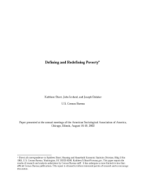Defining and Redefining Poverty
Defining and Redefining Poverty
Abstract
In 1995 the National Academy of Sciences (NAS) Panel on Poverty and Family Assistance released a report, Measuring Poverty: A New Approach, which offered recommendations for improving the official poverty measure. In 1999, the Census Bureau released its first report on experimental poverty measures which implemented most of the NAS Panel recommendations, as agreed upon by a technical working group on poverty measurement chaired by the Office of Management and Budget. Following further research and discussion, a second Census Bureau report was released in 2001. This paper summarizes these efforts and focuses on current challenges. Elements of the experimental measures which continue to receive scrutiny include: the calculation of work-related expenses and childcare, the valuation of housing subsidies, the calculation of medical out-of-pocket spending, and adjustments to poverty thresholds for geographic cost-of-living differences. We also discuss other concerns faced in poverty redefinition efforts, such as determining which methods are conceptually, methodologically, and operationally the most appealing, and incorporating experimental measures in future reports and research.
Others in Series
Working Paper
Working Paper
Working Paper




